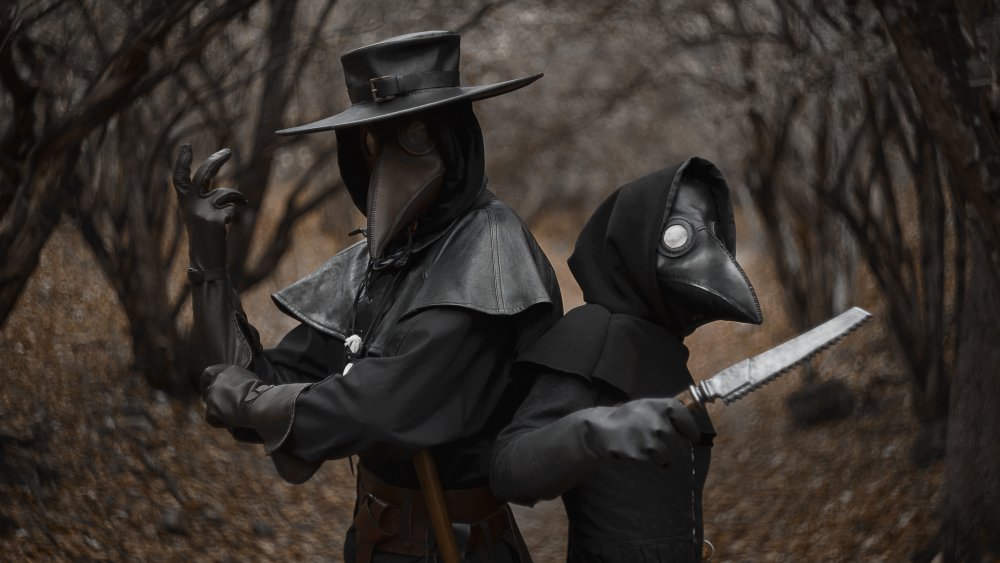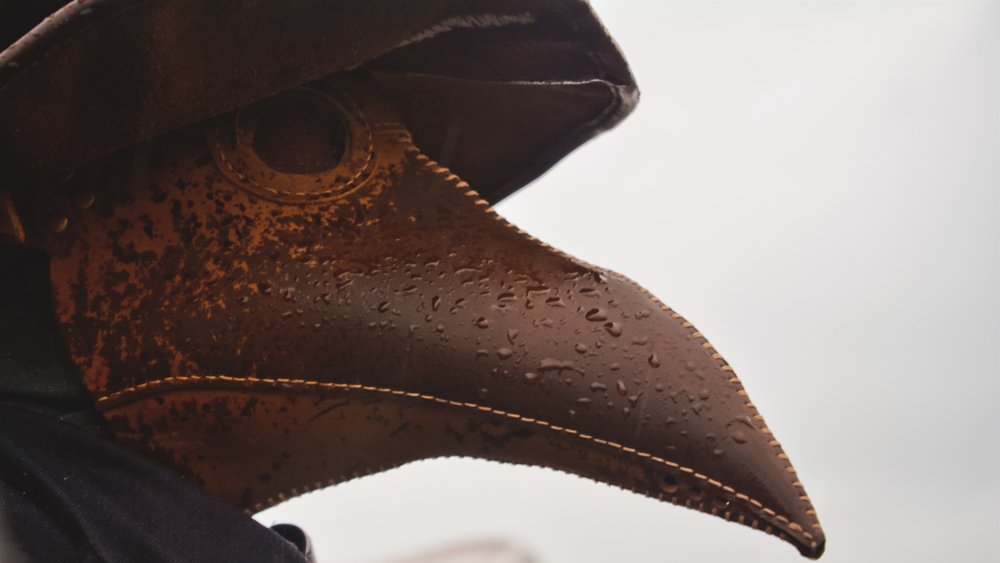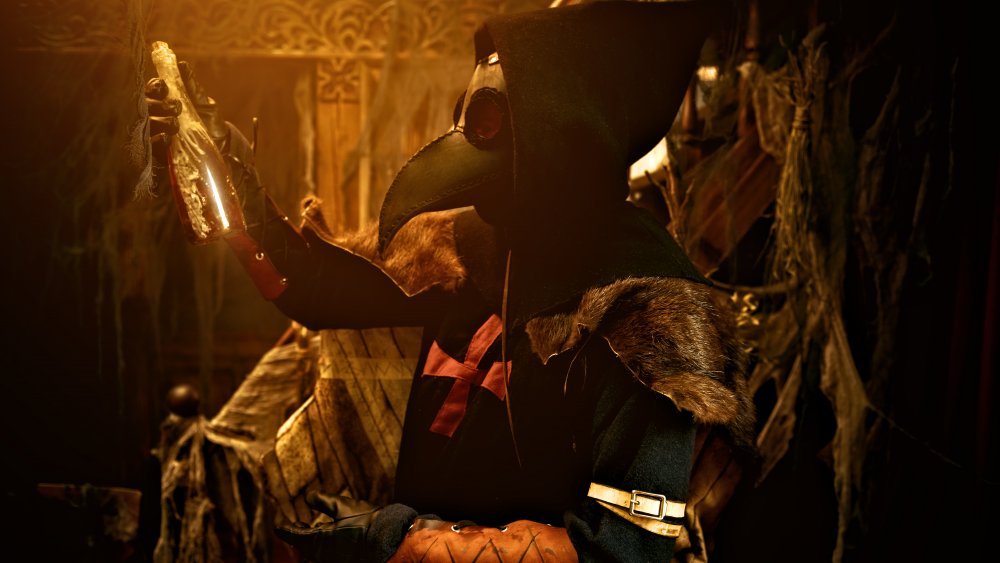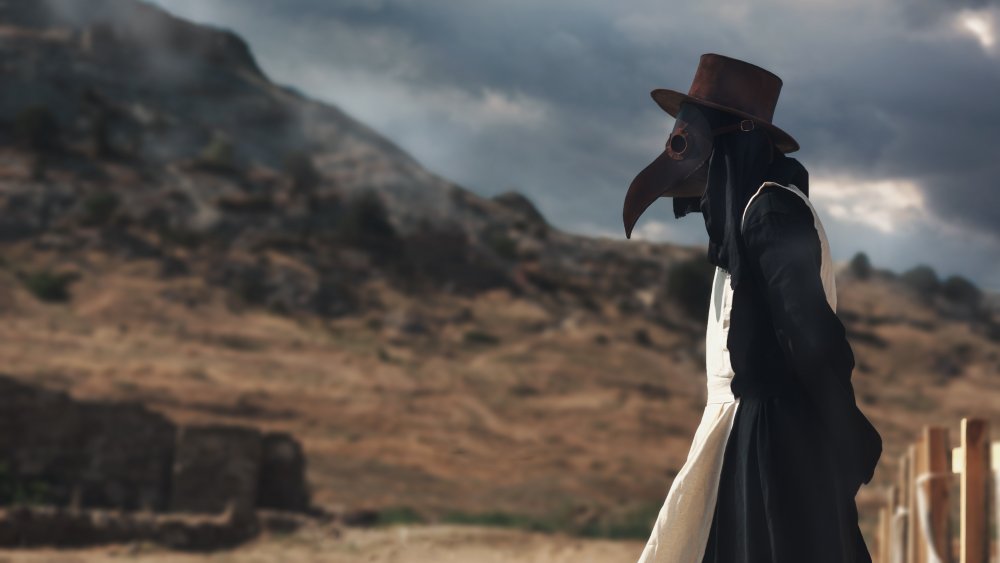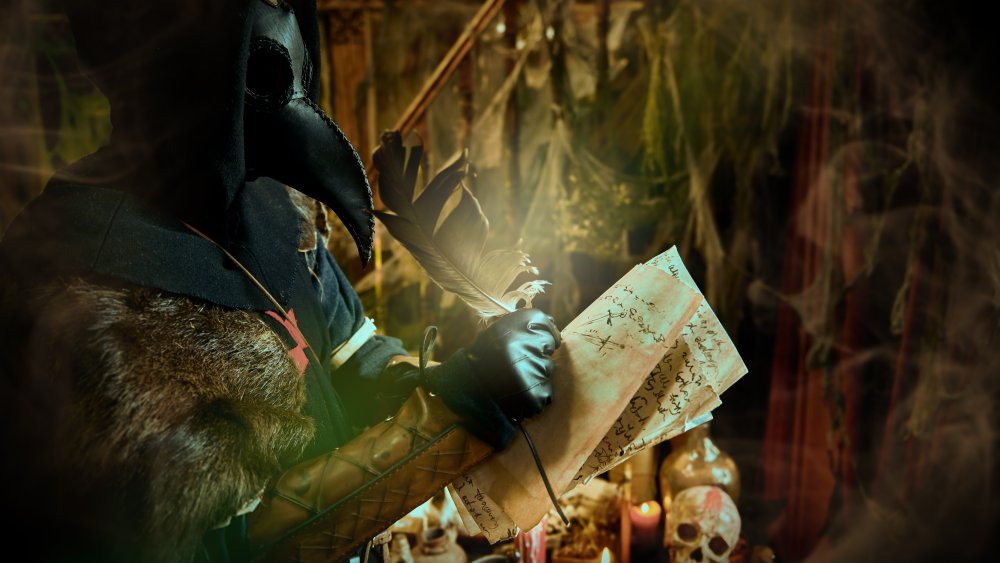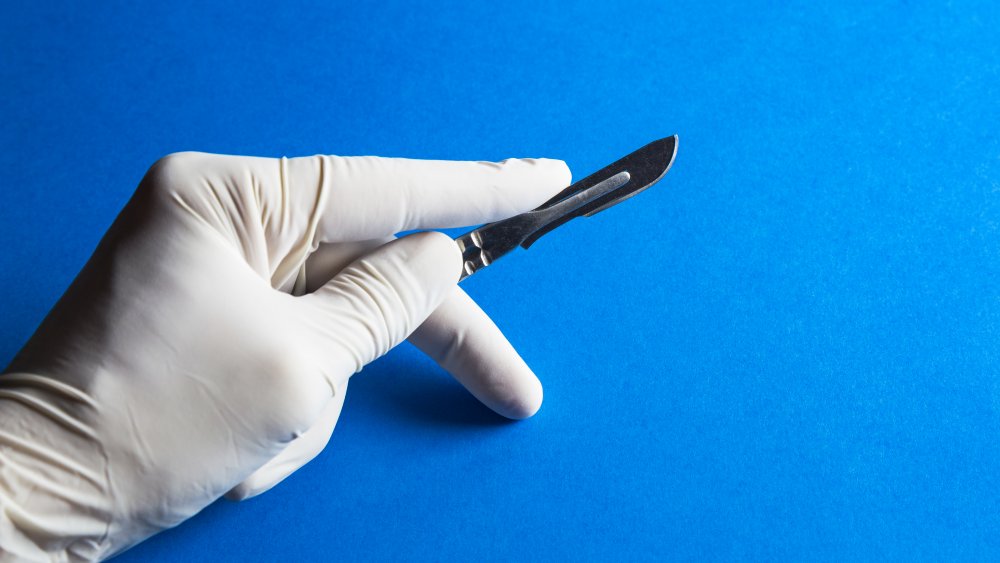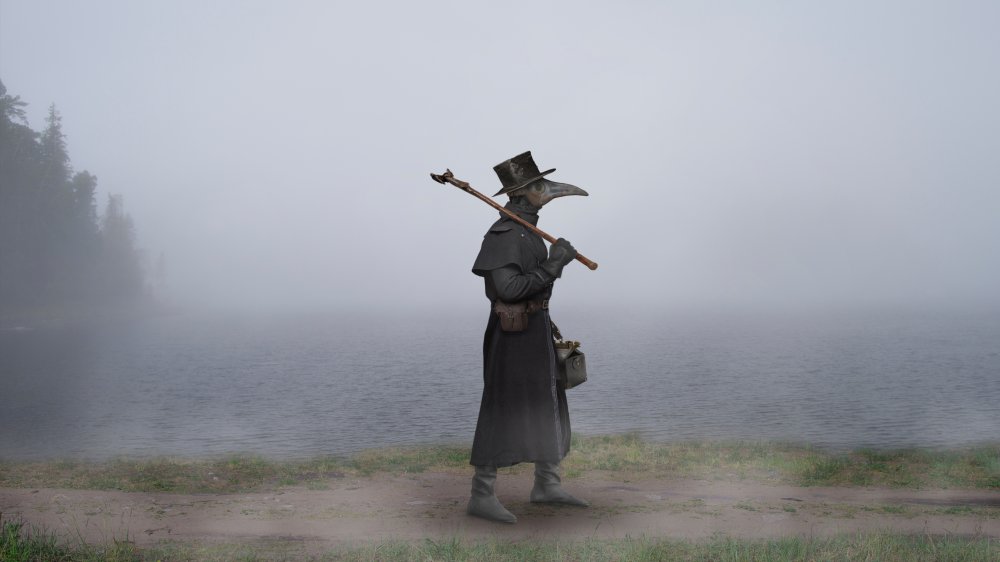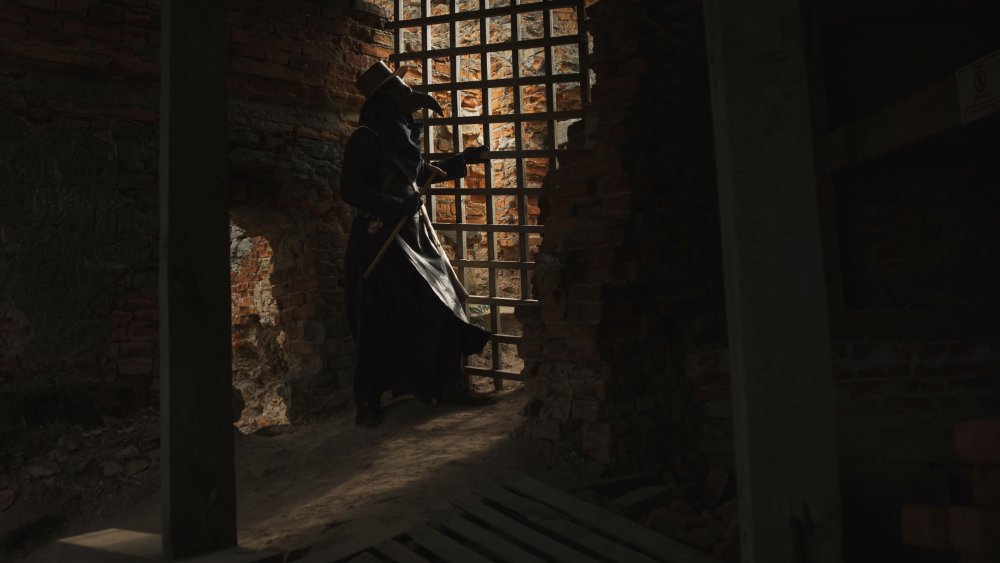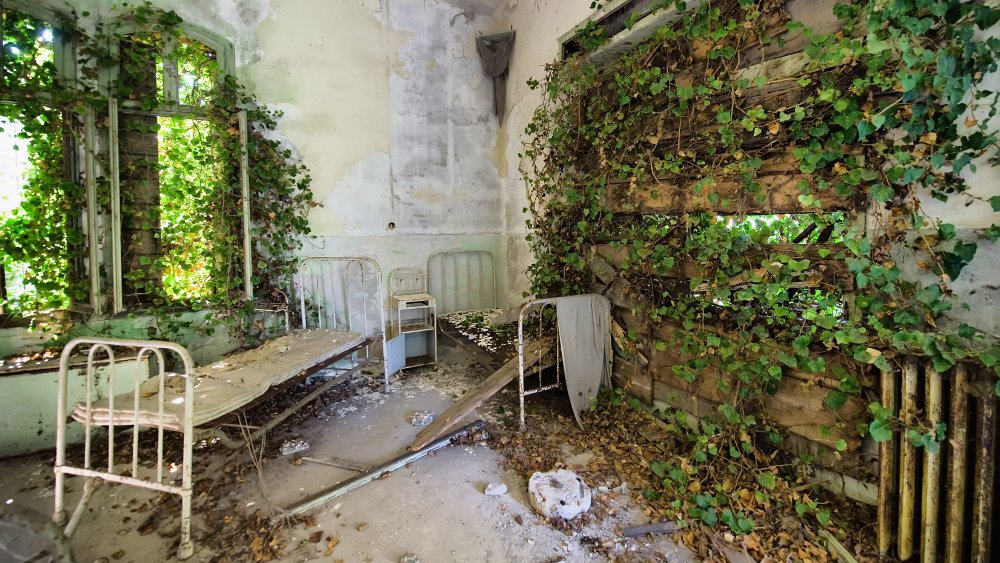What It Was Really Like Being A Plague Doctor
The mention of a plague doctor conjures up images of an unsettling figure in dark robes, sporting a long, beaked mask under a hat ... right? That's actually just part of the story.
Even though that iconic plague doctor costume has become synonymous with the Black Death and the terror of medieval disease — and cures — no medieval plague doctor actually wore it. That costume didn't come until later outbreaks of the plague, and don't worry, there were plenty of disease-filled years left by the time it was invented. Live Science says early plague doctors — those working during the Plague of Justinian, for example, and the Black Death of the 1300s — didn't even have the scant protection that famous beaked mask would have given.
So, why on Earth would anyone want to become a plague doctor? Who were these people? And what was it really like, tending to the sick and fighting a seemingly insurmountable disease that was everywhere? What kind of person becomes a doctor like that ... and just watches their patients die, often quickly and miserably?
Plague doctors were hired out of desperation
The plague — no matter when or where in history it hit — was devastating. It was so devastating, in fact, that many doctors simply gave up. Physicians who had been working in communities for years simply fled, and according to The Medieval City, entire cities were left without a doctor.
The solution was to hire a plague doctor. Who were these people? Most plague doctors were hired by a town or village to care only for the people in that town. While they were carrying out their duties, they were forbidden from interacting with healthy members of the community and could only associate with the sick. That quarantine lasted not just during the plague but afterward, too: Plague doctors would remain on the fringes of society even after the danger had passed.
So, what was going on with those people who did step up and apply to become community plague doctors? (Yes, those who were interested tended to apply for the job.) Generally, there were a few types of people who went this grisly route: There were medical professionals who weren't quite good enough to get a job elsewhere, or there were doctors just starting out, who wanted to get experience and to build a name for themselves. If you were a plague doctor, chances were good that you were doing it because no one else wanted to or because you weren't quite good enough to have other career options.
Plague doctors started with some contractual negotiations
When a doctor found a community that was in need of a plague doctor, it wasn't just a matter of moving in and setting up shop. According to The Medieval City, plague doctors would enter into a contract with the town or city that was hiring them, and negotiations were rarely straightforward. While communities knew they needed a plague doctor, they didn't want to put much further strain on already tough times. But plague doctors also needed contracts that made it worthwhile, and oftentimes, they got them.
Let's take one (of many) existing plague doctor contracts. In 1479, Pavia struck up a contract with Giovanni de Ventura. On top of 30 florins per month, he also got living expenses, two months' salary in advance, a completely furnished house, and another month's pay after his services were no longer needed. He also negotiated for "all and everything which is necessary for his life," which included things like food. And that? That was a huge deal, considering that widespread famine usually came with the plague.
That's not a bad deal, but there's one other thing: Many plague doctors who headed into cities and towns were looking for somewhere to set up a practice. Contracts — like Ventura's — sometimes also gave citizenship to a plague doctor who fulfilled his contract and survived the plague. That could have been life-changing: He would have had a place to live, money set aside, and a community to stay in if he chose.
Plague doctors couldn't be animal people
Part of the plague doctor's daily routine would have — of course — been caring for those in the community who had come down with a case of plague. And that was tricky. According to the Ancient History Encyclopedia, there was no known cure, so doctors kind of had to make things up as they went. There were some things widely believed to help, and many plague doctors were trying things like the Vicary Method.
That was named after the doctor who had first proposed it as a cure for the plague, and unfortunately, we're not sure how Thomas Vicary came up with this particular idea. It involved taking a healthy chicken and plucking all the feathers from its back ... and backside. The chicken would then be strapped to the patient so that the naked parts covered the worst of the buboes, and when the chicken started looking sickly, that's how you knew it was working. Supposedly, the chicken would draw the plague out of the person, and it would be the plague doctor's responsibility to regularly remove and wash the chicken before reapplying it.
There were other animal cures, too, and none worked out well for the animal. A plague doctor might opt to go the snake route, which meant finding one, chopping it into pieces, and applying those pieces to the buboes. Other plague doctors might do the same thing with a pigeon, and no one knows why.
Plague doctors mixed all kinds of tonics, powders, and potions
Medieval plague doctors had a horribly depressing job, and the struggle to find something that worked was real. Many mixed potions, powders, and tonics and then gave them to their patients in an attempt to create a cure, and sometimes, they just ended up killing people faster.
According to the Ancient History Encyclopedia, plague doctors might offer their wealthiest customers a powder made from ground unicorn horn. (It wasn't really, but that's never stopped anyone before.) Other options for the very wealthy or the merchant class might involve grinding emeralds into a powder, mixing them with food or a drink, and serving that up along with a dose of mercury and/or arsenic, which, yes, was deadly. Plague doctors also had something called theriac in their arsenal, which was a complicated syrup made from up to 80 different ingredients ... and opium.
Later plague doctors would have also been very familiar with mixing up a common treatment called Four Thieves Vinegar. The Farmers' Almanac says lore suggests the name — and the drink — came from a group of 18th-century thieves who robbed the homes of plague victims and drank their tonic to protect themselves from the plague. And it may have worked: Some of the components weren't just antibacterial but repelled the insects that were causing the plague. There were various recipes, but basically it was a tonic of herbs — variously including things like wormwood, sage, rosemary, camphor, and clove — left to steep in white wine vinegar.
Plague doctors both hurt and helped
As a plague doctor, a complete lack of squeamishness would have been absolutely necessary, especially when it came time for the bloodletting. The Ancient History Encyclopedia says that bloodletting was a common practice among plague doctors, who had a few different ways of administering this particular treatment. Sometimes — for those who could afford it — leeches would be applied to try to draw out the infection. Those were expensive, though, and sometimes they'd simply make an incision and collect the blood. Some preferred to heat cups and place them over the buboes, and other plague doctors would spend their days lancing buboes and then applying a paste of herbs, human feces, and/or urine from a healthy person.
Medicine was different then.
But here's where the flip side of that comes in. Sometimes, plague doctors were able to do some good. Curing the plague might have been impossible, but according to the Jewish Virtual Library, some doctors did promote more useful treatments. Nostradamus was a plague doctor after he left medical school — and he was convinced that bleeding was dangerous and that personal hygiene was incredibly important. Among his "treatments" were an insistence that bedding be cleaned and changed often, that patients be given fresh air and clean water, that the bodies of the dead be taken away and buried, and that the streets be kept clean.
Accountant of the dead
Being a plague doctor didn't just mean someone spent all of their time tending to the sick and the dying: They were also sort of the accountants and attorneys of the plague.
According to Doctor's Review, a large part of a plague doctor's job was keeping detailed records about who died. They were responsible for keeping logbooks, recording the names of the dead and when they died.
Sometimes, they were tasked with other things, too. As one of the few people who might be brave enough to head into a house filled with people dying of the plague, they were often asked to hold onto important documents and to witness the wills and final wishes of the dying. They were also expected to testify on behalf of their patients if matters came to that, and, needless to say, there were plenty of unscrupulous plague doctors who took full advantage of their dying clients and grieving families.
Plague doctors were paid by the community that hired them, not by individual families or clients ... and here's where things can get a little shady: Some of the contracts plague doctors signed were designed to protect the community, too. Take the agreement between Pavia and Master Giovanni de Ventura, signed in 1479. It specified that he was not allowed to ask patients for payment ... but also said that he was allowed to accept it if it was offered freely. There's a lot of wiggle room there.
Plague doctors were performing autopsies
Plague doctors definitely couldn't be squeamish, and it's not just the caring-for-patients part that required a strong stomach. According to Doctor's Review, plague doctors were often asked to perform autopsies on those who died from their illness.
Medievalists says that medicine in the Middle Ages wasn't just all about plucking chickens and rubbing snake parts on buboes. Times of crisis and widespread death were often seen as an opportunity to learn more about the human body they were trying to treat, and they knew the dead might contain some clues as to how a disease worked. And that? That might lead to a cure.
Contrary to popular belief, there was no papal bull issued that banned dissection or autopsies, and medieval physicians of all kinds wrote about how valuable they could be. Some cities recognized this and did all they could to help. The city of Florence in particular paid to have autopsies done on plague victims in hopes of understanding what was going on, and in Naples, Johannes della Penna did so many autopsies that he was able to determine that those who died very quickly had internal ulcers.
Who were the plague doctors who wore that iconic costume?
In the 17th century, plague doctors got an upgrade to their wardrobe that came thanks to a physician named Charles de Lorme, who was the doctor of a handful of royals, including King Louis XIII.
National Geographic says that he — and his contemporaries — believed in something called the miasma theory, which stated that the plague spread through poisoned air. That's where the masks came in: That long beak was filled with herbs thought to help purify the air and keep the doctor healthy. The beak was filled with all kinds of herbs and flowers, including mint, cloves, camphor, dried roses or carnations, myrrh, and other pungent herbs. The stronger the smell, the better it was thought to work, and sometimes, those herbs and flowers were set on fire and allowed to smolder away. And here's the thing: While it's unclear just how useful the getup was, The Public Domain Review says that it's entirely possible that the heavy leather, ankle-length robe might have provided some very real protection against plague-causing factors, like sneezes.
Also handy? The wand or cane that was a part of the costume, too. While the mask made communication difficult, the wand was used to give instructions, take the pulse of a patient, or keep people away, should they wander too close. Once that distinctive costume was created, plague doctors were often required by law — and the contracts they signed with their communities — to wear it.
Plague doctors believed in the powers of astrology, smells, and hope
According to Live Science, plague doctors did something that was just as important as treating the plague: They gave people hope that someone was there to care for them.
They also wrote a lot of short texts called plague treatises, which were circulated among the medical community and the public. The content varied, but according to Ann Carmichael, a history professor at Indiana University, they often included a record of symptoms, surgical or other medical treatments that had been attempted, and preventative measures people could take.
Some of the texts from periods of plague provide a glimpse into the world that's just heartbreaking. In 1348, for example, Philip VI of France asked the best and brightest minds he could find to explain the sickness devastating his country. At the time, astrology was a science as widely accepted as chemistry or physics is today, and doctors came to the conclusion that when Jupiter, Mars, and Saturn — all hot, violent planets, it was said — aligned in 1345, it created an abnormally hot wind that blew across the surface of the world and brought disease to all those who breathed it. In order to protect against that poisoned air, plague doctors promoted the idea that people should breathe smells that were either very bitter or very sweet.
And at the time, it was as good an explanation as any other.
Plague doctors could order quarantines
One of the heaviest weapons in the world's fight against the plague was quarantine, and according to History, entire cities have been using quarantine measures since the 14th century. The very first large-scale quarantine order was issued in what's now Dubrovnik in 1377, when it was ordered that no one was allowed to come into the city without spending a month in one of the surrounding areas set up to deal with outsiders.
That 30-day quarantine period was called a trentino, but more popular was the 40-day stretch called quarantino. That's where we get the word "quarantine" from today, and it's possible the time frame was extended to a standard 40 days because of the religious significance.
While city officials were allowed to declare longer (or sometimes shorter) periods of quarantine, plague doctors were also given the authority to lengthen or shorten the amount of time a person spent in quarantine. Did it help? Yes, in several ways: It didn't just help contain the disease, but the idea of having laws put in place to obey gave people a sense of agency and helped prevent a descent into anarchy and panic.
Plague doctors were working in hell
In 1485, Venice's government hit upon a new idea: the lazaret. According to National Geographic, it was essentially a hospital built on an island to quarantine the sick and attempt to keep the plague from spreading. Sounds like a good plan, right? For the plague doctors who would have been working there, it would have been like working in hell.
Rocco Benedetti was a 16th-century chronicler who wrote of the conditions on Lazzaretto Vecchio, saying, "It looked like hell ... The sick lay three or four in a bed. [...] Workers collected the dead and threw them in the graves all day without a break. Often the dying ones and the ones too sick to move or talk were taken for dead and thrown on the piled corpses."
Lazarettos didn't seem to get much better as time went on, either. Poveglia (now abandoned, pictured) was used as a quarantine island from 1793 to 1814, and according to Atlas Obscura, the Venetian government sent somewhere around 160,000 people there to die. Rumor has it that about half the island's soil is made up of human remains, and the conditions were so bad that those who try to spend the night there say that they can't: The screams of the victims are still said to haunt the island.
Next time you think your office is too hot or too cold or the donuts too stale, just be glad you're not a plague doctor.
